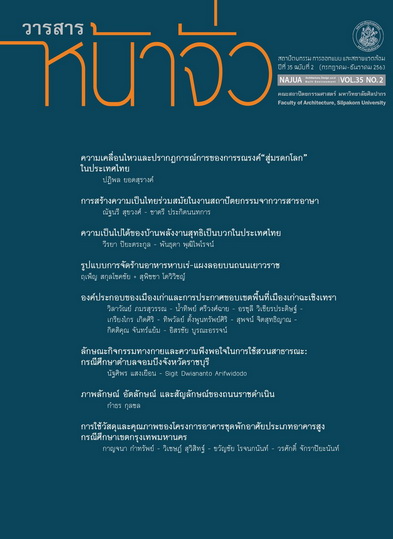Ratchadamnoen Avenue: Image, Identity and Symbol
Keywords:
Ratchadamnoen Avenue, image, identity, symbolAbstract
It is widely known that the Ratchadamnoen Avenue was originated by King Rama V some 120 years ago. Consisting of three parts – the Outer, the Middle, and the Inner; each part of the avenue presently shows its different image, i.e. while the Outer and Inner parts have maintained their original characters, the Middle part was purposely facelifted during the Second World War. Consequently, three different identities have become evident, namely, the Outer part represents the grandeur western promenade of the Neo-Classic City, while the Middle part imitates the renowned French Boulevard, Champs-Élysées, in Paris, with the Democracy Monument in place of Arc de Triomphe. Today, remarkable events throughout history of the kingdom on the Ratchadamnoen Avenue have brought about the symbol for each part: the Outer part symbolizes ‘majestic supremacy’, the Middle part symbolizes ‘democratic freedom’, and the Inner part symbolizes ‘traditional royal ceremonies’.
References
- Kulachol, Kamthorn, and Anamabutr, Rujiroj. (2001). Botrian Lae Prasobkarn Jak Karn Sarng Lae Karn Thamlai Urban Space Bon Tanon Ratchadamnoen. (in Thai). [Lessons and Experiences from the Creation and Destruction of Urban Space on the Ratchadamnoen Avenue].(Proceedings from the Second Symposium of the Thai Council of Deans of Architectural Schools, held at Khonkaen University on February 3, 2001). 2 -32.
- Kulachol, Kamthorn, and Nilkamhaeng, Songsan. (1982). Wiwattanakarn Thang Kaiyapharb Khong Krung Rattanakosin Fung Tawan Awk: Tangtae Gone Rerm Sang Krung Jonthueng Samai Plienplaeng Karn Pogkrong. (in Thai). [The Physical Development of the Eastern Part of Rattanakosin City: From Early Settlement to Regime Change]. Warasarn Mahawittayalai Silpakorn. (Silpakorn University Journal). 4-5. (Special Issue). 221-244.
- Naruemitrekakarn, Sirichai. (1977). Sapan Kao Krungthep. (in Thai). [Old Bridges in Bangkok]. Bangkok: Siam Society.
- Plainoy, Sombat. (1975). Lao RuengBangkok. (in Thai). [A Story Telling about Bangkok]. Bangkok: Prae Pittaya.
- Ratchakitja Nubegsa. (in Thai) [Royal gazette]. v.16.
- Ratha Niyom. (in Thai) [State Doctrine]. Retrieved March 30, 2019, from https://th.wikipedia.org/wiki.
- Sakdisri, Naengnoi, and Others. (1991). Ong Prakorb Thang Kaiyapharb Krung Rattanakosin. (in Thai). [Physical Compositions of Rattanakosin City]. Bangkok: Chulalongkorn University.





